401213 Clinical Leadership Essay: Leadership Styles and Patient Safety
VerifiedAdded on 2022/11/28
|8
|2154
|299
Essay
AI Summary
This essay examines the crucial relationship between clinical leadership and patient safety within the healthcare environment. The paper defines leadership and patient safety, highlighting their interconnectedness. It explores two leadership styles: transformational and democratic leadership, critically analyzing each style's strengths and weaknesses. The essay evaluates how these leadership styles promote patient safety, supported by relevant literature and research. Furthermore, it provides a specific example of medication safety to illustrate the discussion and emphasizes the vital role of nursing leaders in enhancing patient care and outcomes. The essay concludes by reinforcing the significance of effective leadership in ensuring a safe and supportive environment for patients and healthcare professionals.
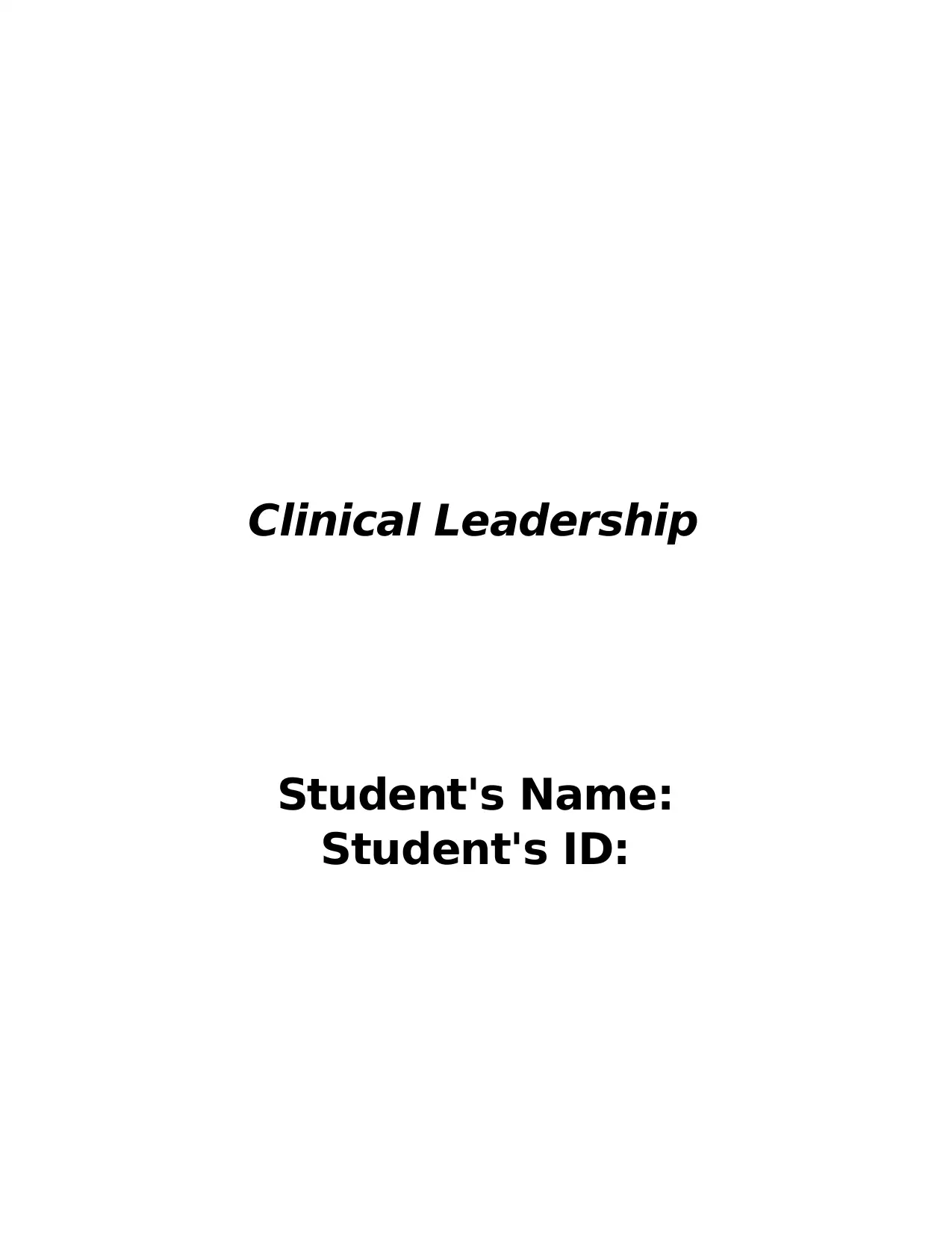
Clinical Leadership
Student's Name:
Student's ID:
Student's Name:
Student's ID:
Paraphrase This Document
Need a fresh take? Get an instant paraphrase of this document with our AI Paraphraser
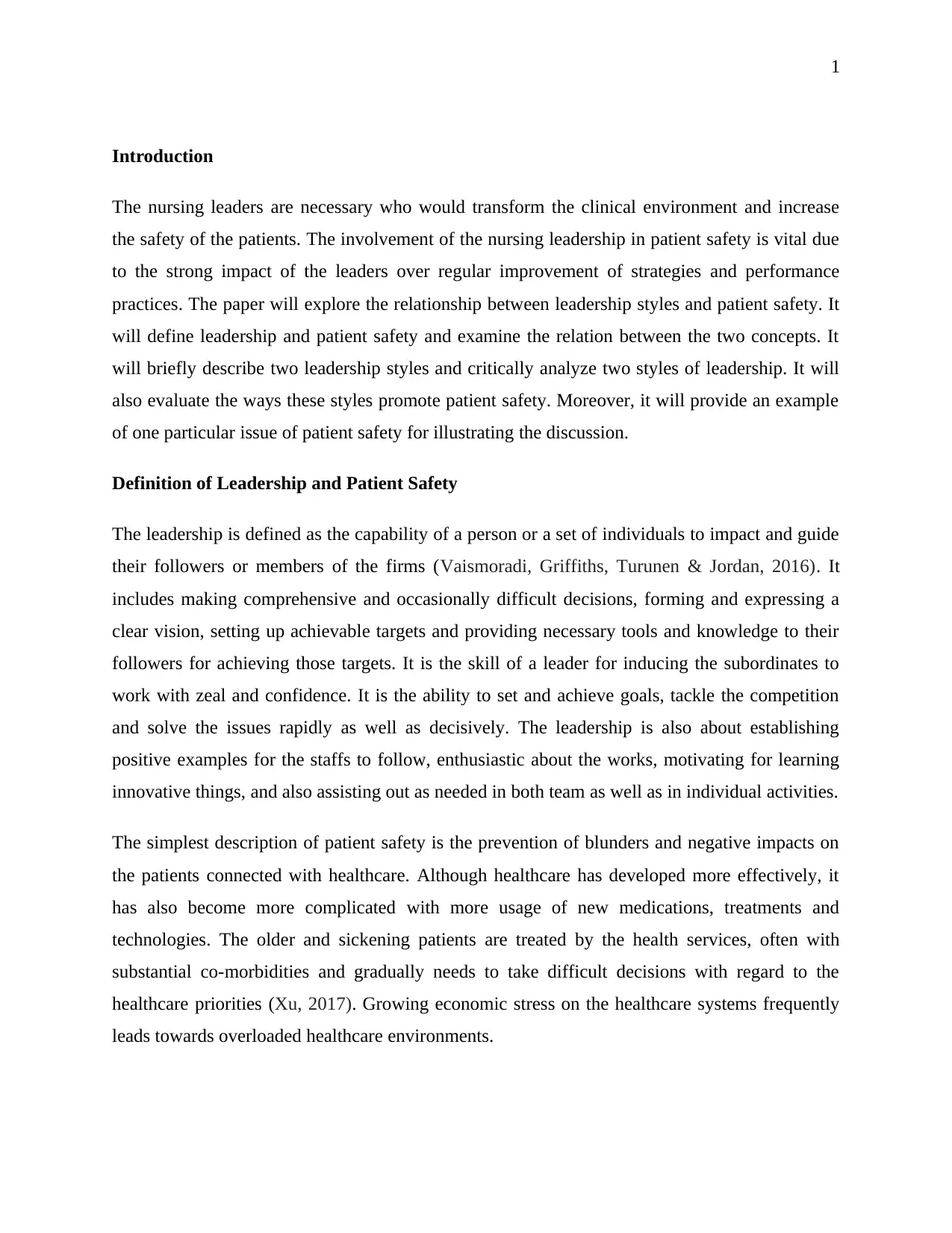
1
Introduction
The nursing leaders are necessary who would transform the clinical environment and increase
the safety of the patients. The involvement of the nursing leadership in patient safety is vital due
to the strong impact of the leaders over regular improvement of strategies and performance
practices. The paper will explore the relationship between leadership styles and patient safety. It
will define leadership and patient safety and examine the relation between the two concepts. It
will briefly describe two leadership styles and critically analyze two styles of leadership. It will
also evaluate the ways these styles promote patient safety. Moreover, it will provide an example
of one particular issue of patient safety for illustrating the discussion.
Definition of Leadership and Patient Safety
The leadership is defined as the capability of a person or a set of individuals to impact and guide
their followers or members of the firms (Vaismoradi, Griffiths, Turunen & Jordan, 2016). It
includes making comprehensive and occasionally difficult decisions, forming and expressing a
clear vision, setting up achievable targets and providing necessary tools and knowledge to their
followers for achieving those targets. It is the skill of a leader for inducing the subordinates to
work with zeal and confidence. It is the ability to set and achieve goals, tackle the competition
and solve the issues rapidly as well as decisively. The leadership is also about establishing
positive examples for the staffs to follow, enthusiastic about the works, motivating for learning
innovative things, and also assisting out as needed in both team as well as in individual activities.
The simplest description of patient safety is the prevention of blunders and negative impacts on
the patients connected with healthcare. Although healthcare has developed more effectively, it
has also become more complicated with more usage of new medications, treatments and
technologies. The older and sickening patients are treated by the health services, often with
substantial co-morbidities and gradually needs to take difficult decisions with regard to the
healthcare priorities (Xu, 2017). Growing economic stress on the healthcare systems frequently
leads towards overloaded healthcare environments.
Introduction
The nursing leaders are necessary who would transform the clinical environment and increase
the safety of the patients. The involvement of the nursing leadership in patient safety is vital due
to the strong impact of the leaders over regular improvement of strategies and performance
practices. The paper will explore the relationship between leadership styles and patient safety. It
will define leadership and patient safety and examine the relation between the two concepts. It
will briefly describe two leadership styles and critically analyze two styles of leadership. It will
also evaluate the ways these styles promote patient safety. Moreover, it will provide an example
of one particular issue of patient safety for illustrating the discussion.
Definition of Leadership and Patient Safety
The leadership is defined as the capability of a person or a set of individuals to impact and guide
their followers or members of the firms (Vaismoradi, Griffiths, Turunen & Jordan, 2016). It
includes making comprehensive and occasionally difficult decisions, forming and expressing a
clear vision, setting up achievable targets and providing necessary tools and knowledge to their
followers for achieving those targets. It is the skill of a leader for inducing the subordinates to
work with zeal and confidence. It is the ability to set and achieve goals, tackle the competition
and solve the issues rapidly as well as decisively. The leadership is also about establishing
positive examples for the staffs to follow, enthusiastic about the works, motivating for learning
innovative things, and also assisting out as needed in both team as well as in individual activities.
The simplest description of patient safety is the prevention of blunders and negative impacts on
the patients connected with healthcare. Although healthcare has developed more effectively, it
has also become more complicated with more usage of new medications, treatments and
technologies. The older and sickening patients are treated by the health services, often with
substantial co-morbidities and gradually needs to take difficult decisions with regard to the
healthcare priorities (Xu, 2017). Growing economic stress on the healthcare systems frequently
leads towards overloaded healthcare environments.
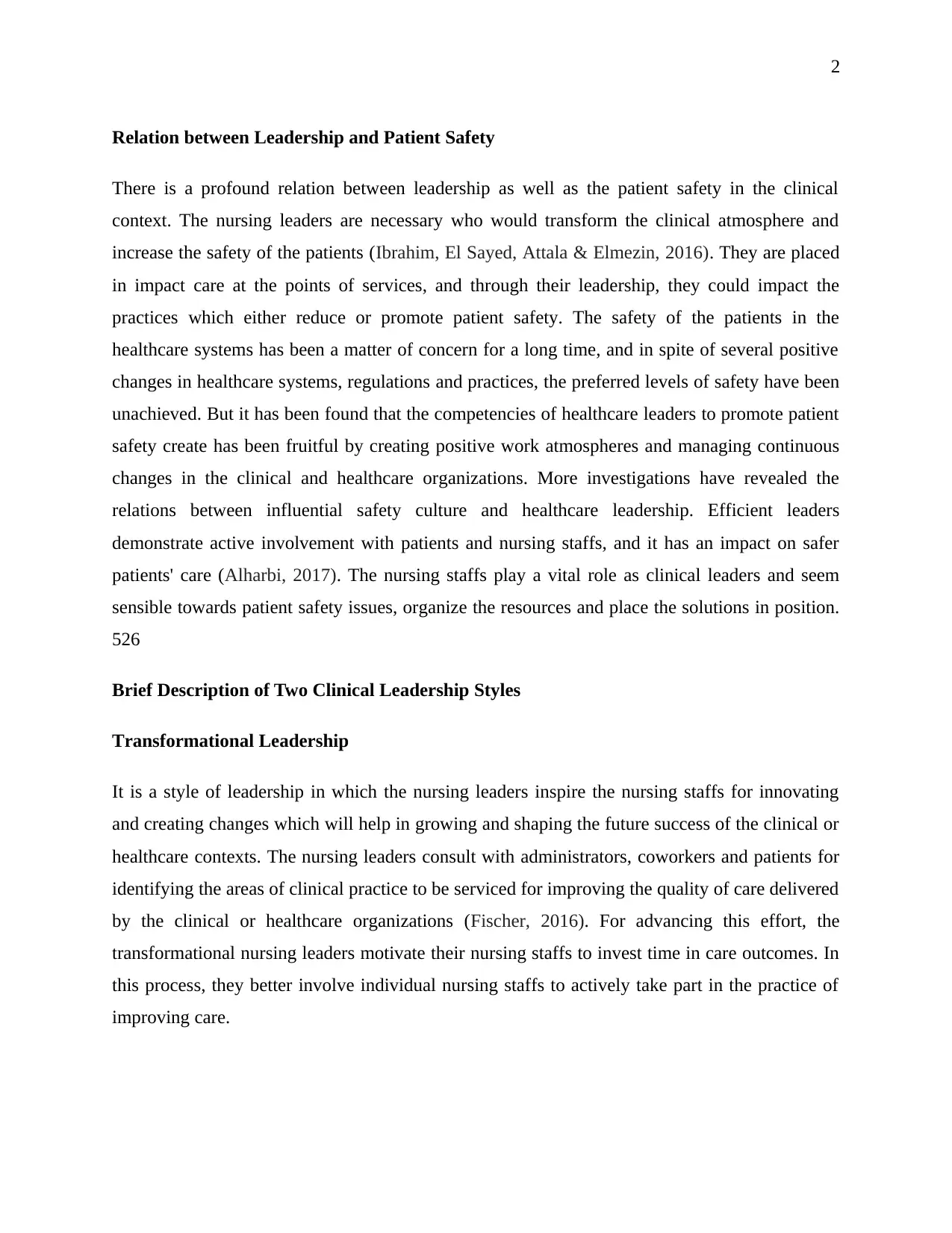
2
Relation between Leadership and Patient Safety
There is a profound relation between leadership as well as the patient safety in the clinical
context. The nursing leaders are necessary who would transform the clinical atmosphere and
increase the safety of the patients (Ibrahim, El Sayed, Attala & Elmezin, 2016). They are placed
in impact care at the points of services, and through their leadership, they could impact the
practices which either reduce or promote patient safety. The safety of the patients in the
healthcare systems has been a matter of concern for a long time, and in spite of several positive
changes in healthcare systems, regulations and practices, the preferred levels of safety have been
unachieved. But it has been found that the competencies of healthcare leaders to promote patient
safety create has been fruitful by creating positive work atmospheres and managing continuous
changes in the clinical and healthcare organizations. More investigations have revealed the
relations between influential safety culture and healthcare leadership. Efficient leaders
demonstrate active involvement with patients and nursing staffs, and it has an impact on safer
patients' care (Alharbi, 2017). The nursing staffs play a vital role as clinical leaders and seem
sensible towards patient safety issues, organize the resources and place the solutions in position.
526
Brief Description of Two Clinical Leadership Styles
Transformational Leadership
It is a style of leadership in which the nursing leaders inspire the nursing staffs for innovating
and creating changes which will help in growing and shaping the future success of the clinical or
healthcare contexts. The nursing leaders consult with administrators, coworkers and patients for
identifying the areas of clinical practice to be serviced for improving the quality of care delivered
by the clinical or healthcare organizations (Fischer, 2016). For advancing this effort, the
transformational nursing leaders motivate their nursing staffs to invest time in care outcomes. In
this process, they better involve individual nursing staffs to actively take part in the practice of
improving care.
Relation between Leadership and Patient Safety
There is a profound relation between leadership as well as the patient safety in the clinical
context. The nursing leaders are necessary who would transform the clinical atmosphere and
increase the safety of the patients (Ibrahim, El Sayed, Attala & Elmezin, 2016). They are placed
in impact care at the points of services, and through their leadership, they could impact the
practices which either reduce or promote patient safety. The safety of the patients in the
healthcare systems has been a matter of concern for a long time, and in spite of several positive
changes in healthcare systems, regulations and practices, the preferred levels of safety have been
unachieved. But it has been found that the competencies of healthcare leaders to promote patient
safety create has been fruitful by creating positive work atmospheres and managing continuous
changes in the clinical and healthcare organizations. More investigations have revealed the
relations between influential safety culture and healthcare leadership. Efficient leaders
demonstrate active involvement with patients and nursing staffs, and it has an impact on safer
patients' care (Alharbi, 2017). The nursing staffs play a vital role as clinical leaders and seem
sensible towards patient safety issues, organize the resources and place the solutions in position.
526
Brief Description of Two Clinical Leadership Styles
Transformational Leadership
It is a style of leadership in which the nursing leaders inspire the nursing staffs for innovating
and creating changes which will help in growing and shaping the future success of the clinical or
healthcare contexts. The nursing leaders consult with administrators, coworkers and patients for
identifying the areas of clinical practice to be serviced for improving the quality of care delivered
by the clinical or healthcare organizations (Fischer, 2016). For advancing this effort, the
transformational nursing leaders motivate their nursing staffs to invest time in care outcomes. In
this process, they better involve individual nursing staffs to actively take part in the practice of
improving care.
⊘ This is a preview!⊘
Do you want full access?
Subscribe today to unlock all pages.

Trusted by 1+ million students worldwide
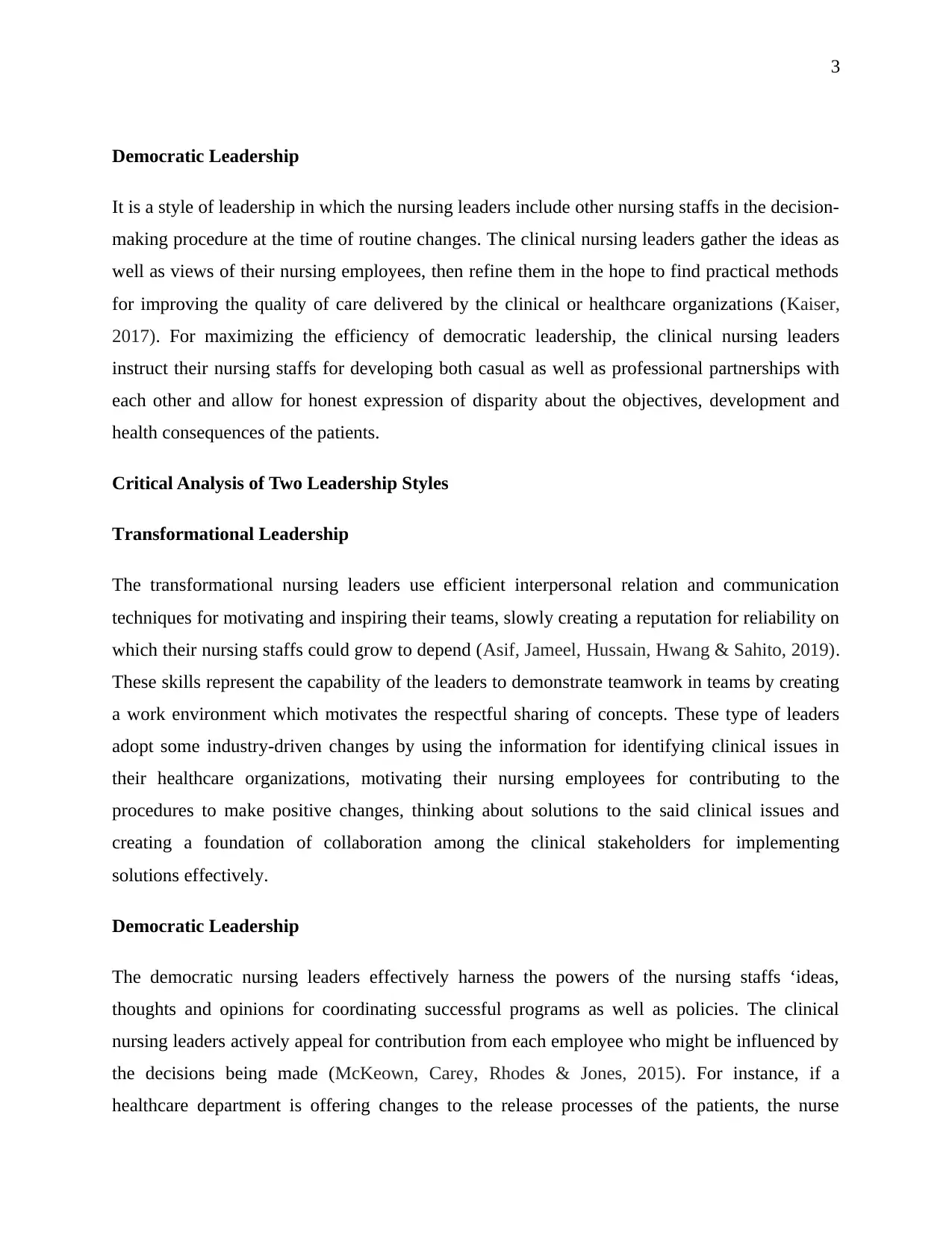
3
Democratic Leadership
It is a style of leadership in which the nursing leaders include other nursing staffs in the decision-
making procedure at the time of routine changes. The clinical nursing leaders gather the ideas as
well as views of their nursing employees, then refine them in the hope to find practical methods
for improving the quality of care delivered by the clinical or healthcare organizations (Kaiser,
2017). For maximizing the efficiency of democratic leadership, the clinical nursing leaders
instruct their nursing staffs for developing both casual as well as professional partnerships with
each other and allow for honest expression of disparity about the objectives, development and
health consequences of the patients.
Critical Analysis of Two Leadership Styles
Transformational Leadership
The transformational nursing leaders use efficient interpersonal relation and communication
techniques for motivating and inspiring their teams, slowly creating a reputation for reliability on
which their nursing staffs could grow to depend (Asif, Jameel, Hussain, Hwang & Sahito, 2019).
These skills represent the capability of the leaders to demonstrate teamwork in teams by creating
a work environment which motivates the respectful sharing of concepts. These type of leaders
adopt some industry-driven changes by using the information for identifying clinical issues in
their healthcare organizations, motivating their nursing employees for contributing to the
procedures to make positive changes, thinking about solutions to the said clinical issues and
creating a foundation of collaboration among the clinical stakeholders for implementing
solutions effectively.
Democratic Leadership
The democratic nursing leaders effectively harness the powers of the nursing staffs ‘ideas,
thoughts and opinions for coordinating successful programs as well as policies. The clinical
nursing leaders actively appeal for contribution from each employee who might be influenced by
the decisions being made (McKeown, Carey, Rhodes & Jones, 2015). For instance, if a
healthcare department is offering changes to the release processes of the patients, the nurse
Democratic Leadership
It is a style of leadership in which the nursing leaders include other nursing staffs in the decision-
making procedure at the time of routine changes. The clinical nursing leaders gather the ideas as
well as views of their nursing employees, then refine them in the hope to find practical methods
for improving the quality of care delivered by the clinical or healthcare organizations (Kaiser,
2017). For maximizing the efficiency of democratic leadership, the clinical nursing leaders
instruct their nursing staffs for developing both casual as well as professional partnerships with
each other and allow for honest expression of disparity about the objectives, development and
health consequences of the patients.
Critical Analysis of Two Leadership Styles
Transformational Leadership
The transformational nursing leaders use efficient interpersonal relation and communication
techniques for motivating and inspiring their teams, slowly creating a reputation for reliability on
which their nursing staffs could grow to depend (Asif, Jameel, Hussain, Hwang & Sahito, 2019).
These skills represent the capability of the leaders to demonstrate teamwork in teams by creating
a work environment which motivates the respectful sharing of concepts. These type of leaders
adopt some industry-driven changes by using the information for identifying clinical issues in
their healthcare organizations, motivating their nursing employees for contributing to the
procedures to make positive changes, thinking about solutions to the said clinical issues and
creating a foundation of collaboration among the clinical stakeholders for implementing
solutions effectively.
Democratic Leadership
The democratic nursing leaders effectively harness the powers of the nursing staffs ‘ideas,
thoughts and opinions for coordinating successful programs as well as policies. The clinical
nursing leaders actively appeal for contribution from each employee who might be influenced by
the decisions being made (McKeown, Carey, Rhodes & Jones, 2015). For instance, if a
healthcare department is offering changes to the release processes of the patients, the nurse
Paraphrase This Document
Need a fresh take? Get an instant paraphrase of this document with our AI Paraphraser
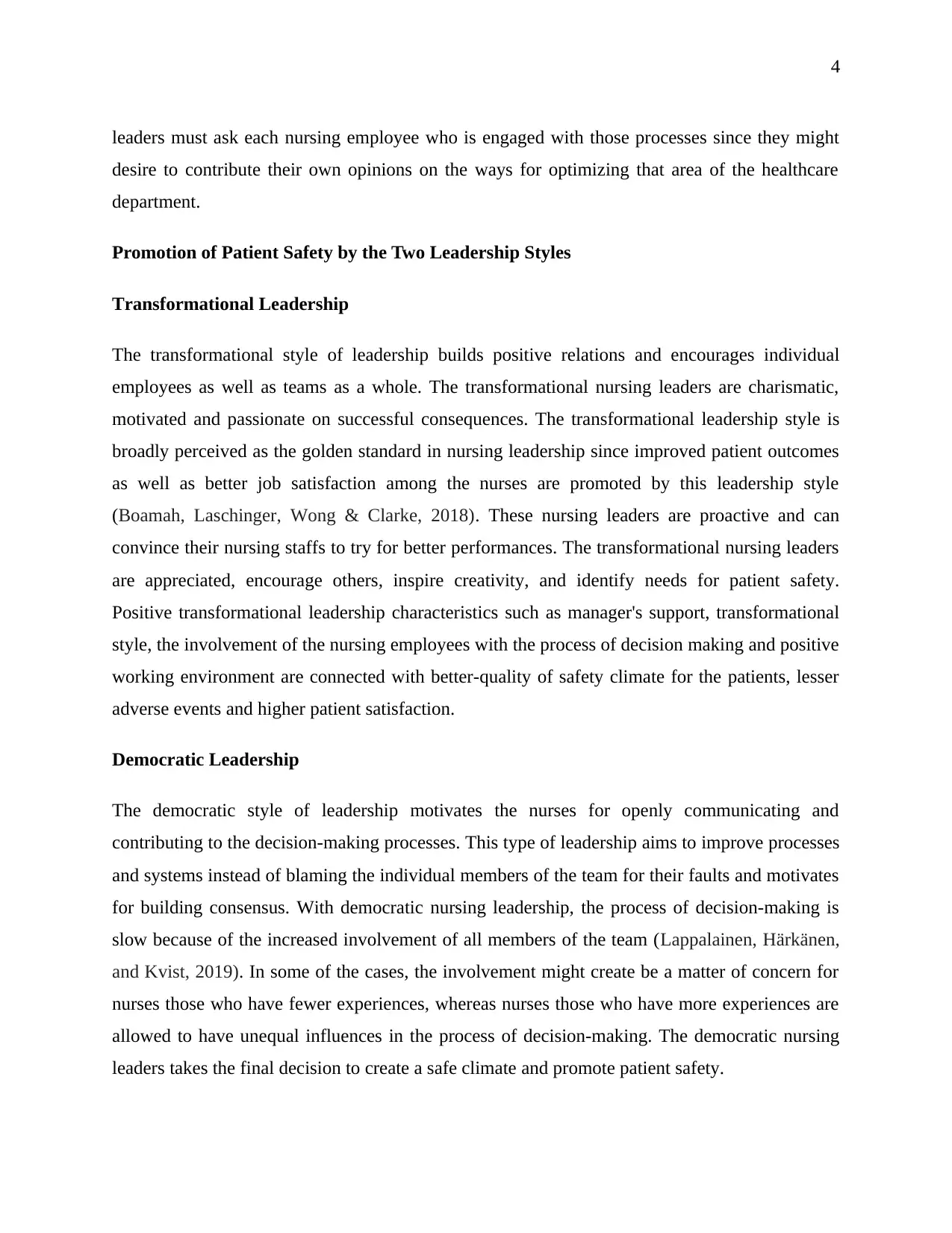
4
leaders must ask each nursing employee who is engaged with those processes since they might
desire to contribute their own opinions on the ways for optimizing that area of the healthcare
department.
Promotion of Patient Safety by the Two Leadership Styles
Transformational Leadership
The transformational style of leadership builds positive relations and encourages individual
employees as well as teams as a whole. The transformational nursing leaders are charismatic,
motivated and passionate on successful consequences. The transformational leadership style is
broadly perceived as the golden standard in nursing leadership since improved patient outcomes
as well as better job satisfaction among the nurses are promoted by this leadership style
(Boamah, Laschinger, Wong & Clarke, 2018). These nursing leaders are proactive and can
convince their nursing staffs to try for better performances. The transformational nursing leaders
are appreciated, encourage others, inspire creativity, and identify needs for patient safety.
Positive transformational leadership characteristics such as manager's support, transformational
style, the involvement of the nursing employees with the process of decision making and positive
working environment are connected with better-quality of safety climate for the patients, lesser
adverse events and higher patient satisfaction.
Democratic Leadership
The democratic style of leadership motivates the nurses for openly communicating and
contributing to the decision-making processes. This type of leadership aims to improve processes
and systems instead of blaming the individual members of the team for their faults and motivates
for building consensus. With democratic nursing leadership, the process of decision-making is
slow because of the increased involvement of all members of the team (Lappalainen, Härkänen,
and Kvist, 2019). In some of the cases, the involvement might create be a matter of concern for
nurses those who have fewer experiences, whereas nurses those who have more experiences are
allowed to have unequal influences in the process of decision-making. The democratic nursing
leaders takes the final decision to create a safe climate and promote patient safety.
leaders must ask each nursing employee who is engaged with those processes since they might
desire to contribute their own opinions on the ways for optimizing that area of the healthcare
department.
Promotion of Patient Safety by the Two Leadership Styles
Transformational Leadership
The transformational style of leadership builds positive relations and encourages individual
employees as well as teams as a whole. The transformational nursing leaders are charismatic,
motivated and passionate on successful consequences. The transformational leadership style is
broadly perceived as the golden standard in nursing leadership since improved patient outcomes
as well as better job satisfaction among the nurses are promoted by this leadership style
(Boamah, Laschinger, Wong & Clarke, 2018). These nursing leaders are proactive and can
convince their nursing staffs to try for better performances. The transformational nursing leaders
are appreciated, encourage others, inspire creativity, and identify needs for patient safety.
Positive transformational leadership characteristics such as manager's support, transformational
style, the involvement of the nursing employees with the process of decision making and positive
working environment are connected with better-quality of safety climate for the patients, lesser
adverse events and higher patient satisfaction.
Democratic Leadership
The democratic style of leadership motivates the nurses for openly communicating and
contributing to the decision-making processes. This type of leadership aims to improve processes
and systems instead of blaming the individual members of the team for their faults and motivates
for building consensus. With democratic nursing leadership, the process of decision-making is
slow because of the increased involvement of all members of the team (Lappalainen, Härkänen,
and Kvist, 2019). In some of the cases, the involvement might create be a matter of concern for
nurses those who have fewer experiences, whereas nurses those who have more experiences are
allowed to have unequal influences in the process of decision-making. The democratic nursing
leaders takes the final decision to create a safe climate and promote patient safety.
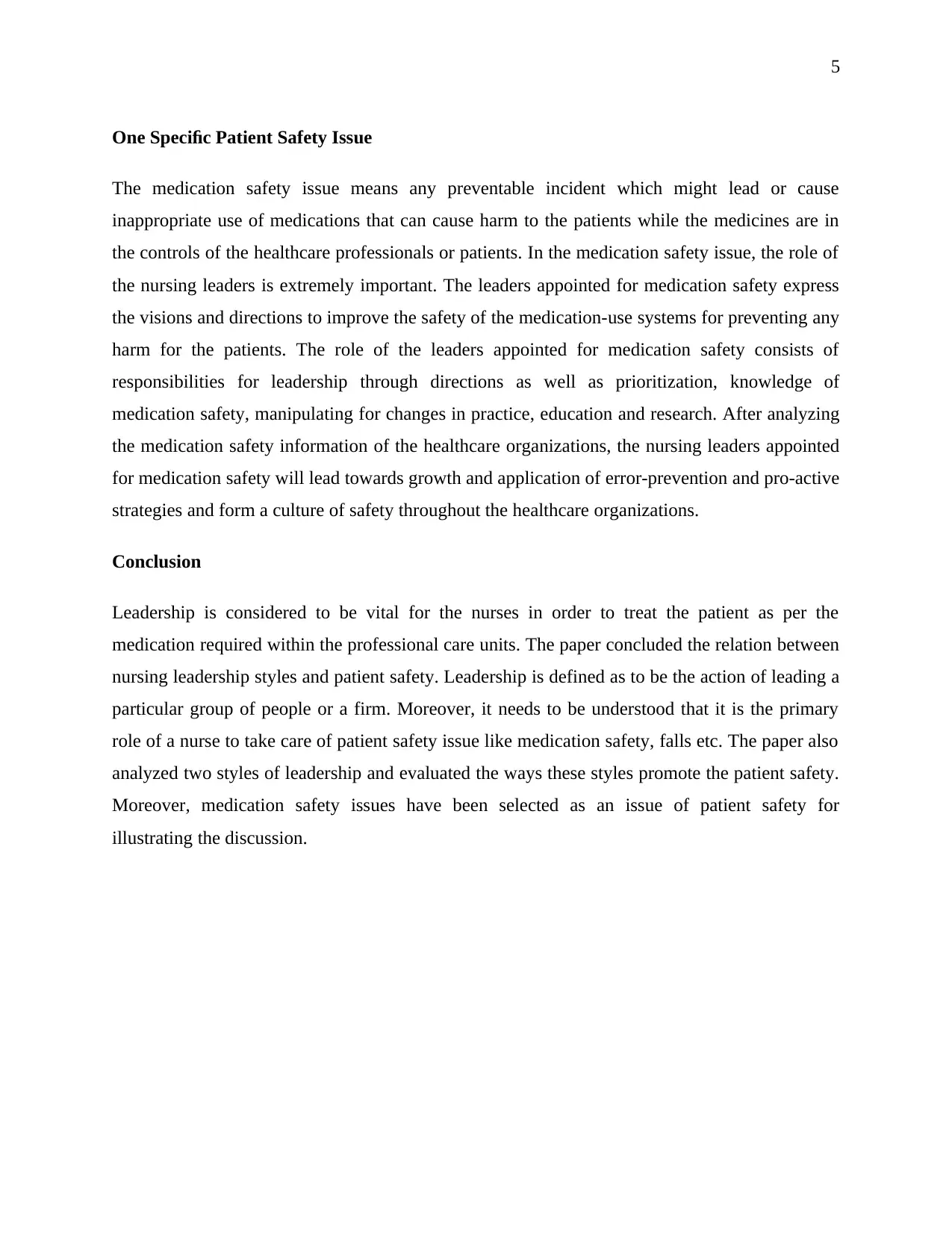
5
One Specific Patient Safety Issue
The medication safety issue means any preventable incident which might lead or cause
inappropriate use of medications that can cause harm to the patients while the medicines are in
the controls of the healthcare professionals or patients. In the medication safety issue, the role of
the nursing leaders is extremely important. The leaders appointed for medication safety express
the visions and directions to improve the safety of the medication-use systems for preventing any
harm for the patients. The role of the leaders appointed for medication safety consists of
responsibilities for leadership through directions as well as prioritization, knowledge of
medication safety, manipulating for changes in practice, education and research. After analyzing
the medication safety information of the healthcare organizations, the nursing leaders appointed
for medication safety will lead towards growth and application of error-prevention and pro-active
strategies and form a culture of safety throughout the healthcare organizations.
Conclusion
Leadership is considered to be vital for the nurses in order to treat the patient as per the
medication required within the professional care units. The paper concluded the relation between
nursing leadership styles and patient safety. Leadership is defined as to be the action of leading a
particular group of people or a firm. Moreover, it needs to be understood that it is the primary
role of a nurse to take care of patient safety issue like medication safety, falls etc. The paper also
analyzed two styles of leadership and evaluated the ways these styles promote the patient safety.
Moreover, medication safety issues have been selected as an issue of patient safety for
illustrating the discussion.
One Specific Patient Safety Issue
The medication safety issue means any preventable incident which might lead or cause
inappropriate use of medications that can cause harm to the patients while the medicines are in
the controls of the healthcare professionals or patients. In the medication safety issue, the role of
the nursing leaders is extremely important. The leaders appointed for medication safety express
the visions and directions to improve the safety of the medication-use systems for preventing any
harm for the patients. The role of the leaders appointed for medication safety consists of
responsibilities for leadership through directions as well as prioritization, knowledge of
medication safety, manipulating for changes in practice, education and research. After analyzing
the medication safety information of the healthcare organizations, the nursing leaders appointed
for medication safety will lead towards growth and application of error-prevention and pro-active
strategies and form a culture of safety throughout the healthcare organizations.
Conclusion
Leadership is considered to be vital for the nurses in order to treat the patient as per the
medication required within the professional care units. The paper concluded the relation between
nursing leadership styles and patient safety. Leadership is defined as to be the action of leading a
particular group of people or a firm. Moreover, it needs to be understood that it is the primary
role of a nurse to take care of patient safety issue like medication safety, falls etc. The paper also
analyzed two styles of leadership and evaluated the ways these styles promote the patient safety.
Moreover, medication safety issues have been selected as an issue of patient safety for
illustrating the discussion.
⊘ This is a preview!⊘
Do you want full access?
Subscribe today to unlock all pages.

Trusted by 1+ million students worldwide
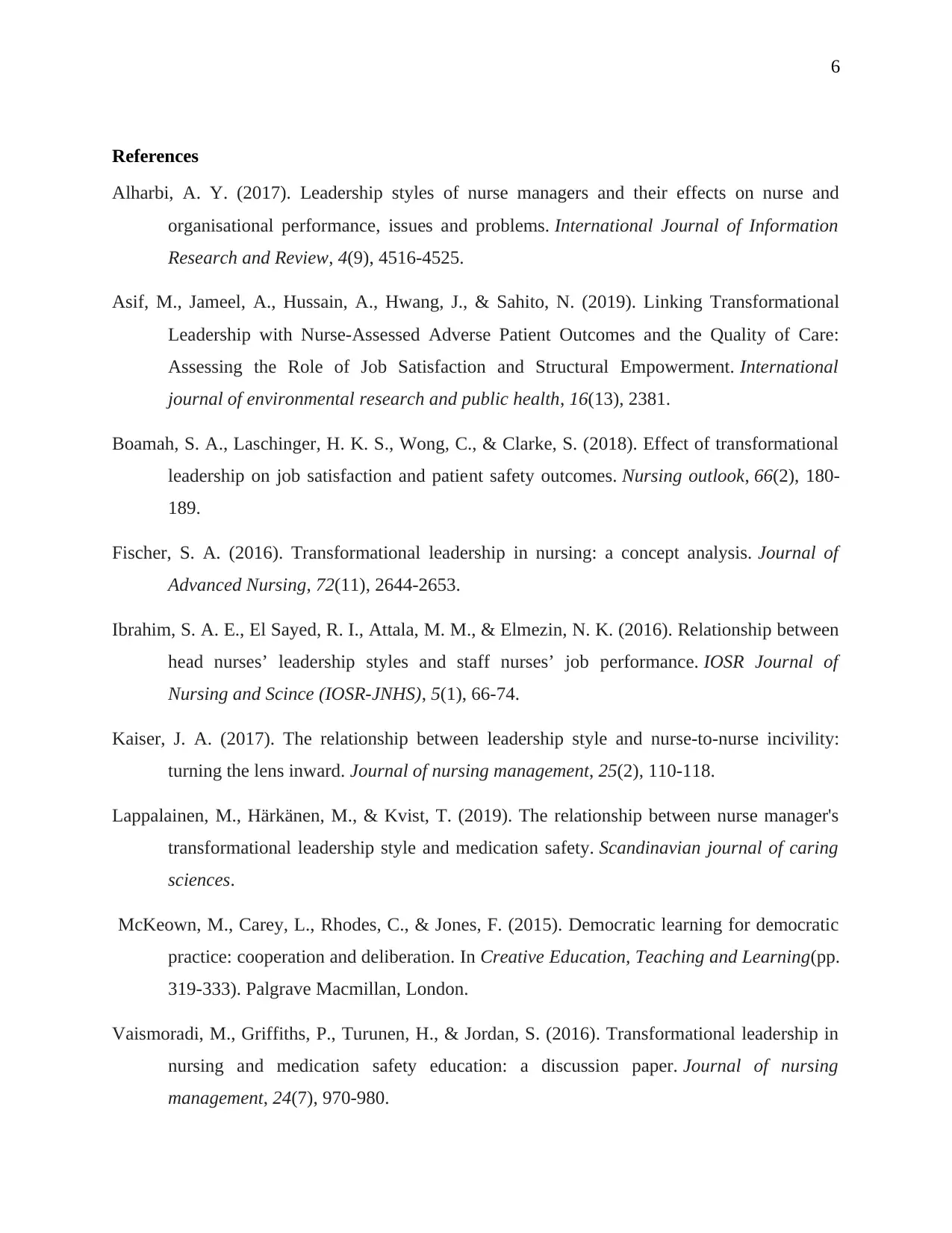
6
References
Alharbi, A. Y. (2017). Leadership styles of nurse managers and their effects on nurse and
organisational performance, issues and problems. International Journal of Information
Research and Review, 4(9), 4516-4525.
Asif, M., Jameel, A., Hussain, A., Hwang, J., & Sahito, N. (2019). Linking Transformational
Leadership with Nurse-Assessed Adverse Patient Outcomes and the Quality of Care:
Assessing the Role of Job Satisfaction and Structural Empowerment. International
journal of environmental research and public health, 16(13), 2381.
Boamah, S. A., Laschinger, H. K. S., Wong, C., & Clarke, S. (2018). Effect of transformational
leadership on job satisfaction and patient safety outcomes. Nursing outlook, 66(2), 180-
189.
Fischer, S. A. (2016). Transformational leadership in nursing: a concept analysis. Journal of
Advanced Nursing, 72(11), 2644-2653.
Ibrahim, S. A. E., El Sayed, R. I., Attala, M. M., & Elmezin, N. K. (2016). Relationship between
head nurses’ leadership styles and staff nurses’ job performance. IOSR Journal of
Nursing and Scince (IOSR-JNHS), 5(1), 66-74.
Kaiser, J. A. (2017). The relationship between leadership style and nurse‐to‐nurse incivility:
turning the lens inward. Journal of nursing management, 25(2), 110-118.
Lappalainen, M., Härkänen, M., & Kvist, T. (2019). The relationship between nurse manager's
transformational leadership style and medication safety. Scandinavian journal of caring
sciences.
McKeown, M., Carey, L., Rhodes, C., & Jones, F. (2015). Democratic learning for democratic
practice: cooperation and deliberation. In Creative Education, Teaching and Learning(pp.
319-333). Palgrave Macmillan, London.
Vaismoradi, M., Griffiths, P., Turunen, H., & Jordan, S. (2016). Transformational leadership in
nursing and medication safety education: a discussion paper. Journal of nursing
management, 24(7), 970-980.
References
Alharbi, A. Y. (2017). Leadership styles of nurse managers and their effects on nurse and
organisational performance, issues and problems. International Journal of Information
Research and Review, 4(9), 4516-4525.
Asif, M., Jameel, A., Hussain, A., Hwang, J., & Sahito, N. (2019). Linking Transformational
Leadership with Nurse-Assessed Adverse Patient Outcomes and the Quality of Care:
Assessing the Role of Job Satisfaction and Structural Empowerment. International
journal of environmental research and public health, 16(13), 2381.
Boamah, S. A., Laschinger, H. K. S., Wong, C., & Clarke, S. (2018). Effect of transformational
leadership on job satisfaction and patient safety outcomes. Nursing outlook, 66(2), 180-
189.
Fischer, S. A. (2016). Transformational leadership in nursing: a concept analysis. Journal of
Advanced Nursing, 72(11), 2644-2653.
Ibrahim, S. A. E., El Sayed, R. I., Attala, M. M., & Elmezin, N. K. (2016). Relationship between
head nurses’ leadership styles and staff nurses’ job performance. IOSR Journal of
Nursing and Scince (IOSR-JNHS), 5(1), 66-74.
Kaiser, J. A. (2017). The relationship between leadership style and nurse‐to‐nurse incivility:
turning the lens inward. Journal of nursing management, 25(2), 110-118.
Lappalainen, M., Härkänen, M., & Kvist, T. (2019). The relationship between nurse manager's
transformational leadership style and medication safety. Scandinavian journal of caring
sciences.
McKeown, M., Carey, L., Rhodes, C., & Jones, F. (2015). Democratic learning for democratic
practice: cooperation and deliberation. In Creative Education, Teaching and Learning(pp.
319-333). Palgrave Macmillan, London.
Vaismoradi, M., Griffiths, P., Turunen, H., & Jordan, S. (2016). Transformational leadership in
nursing and medication safety education: a discussion paper. Journal of nursing
management, 24(7), 970-980.
Paraphrase This Document
Need a fresh take? Get an instant paraphrase of this document with our AI Paraphraser

7
Xu, J. H. (2017). Leadership theory in clinical practice. Chinese Nursing Research, 4(4), 155-
157.
Xu, J. H. (2017). Leadership theory in clinical practice. Chinese Nursing Research, 4(4), 155-
157.
1 out of 8
Related Documents
Your All-in-One AI-Powered Toolkit for Academic Success.
+13062052269
info@desklib.com
Available 24*7 on WhatsApp / Email
![[object Object]](/_next/static/media/star-bottom.7253800d.svg)
Unlock your academic potential
Copyright © 2020–2025 A2Z Services. All Rights Reserved. Developed and managed by ZUCOL.





